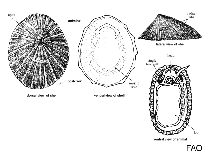Lottia digitalis (Rathke, 1833)
Ribbed limpet| Native range | All suitable habitat | Point map | Year 2050 |

|
| This map was computer-generated and has not yet been reviewed. |
| Lottia digitalis AquaMaps Data sources: GBIF OBIS |
تصوير گوگل | No image available for this species;
drawing shows typical species in Lottiidae.
رده بندی / Names اسامي عام | مترادف | CoL | ITIS | WoRMS
Gastropoda | Not assigned | Lottiidae
Environment: milieu / climate zone / تغييرات عمق / distribution range بوم شناسي
. Subtropical
Distribution كشورها | مناطق سازمان خوار و بار جهاني (FAO) | Ecosystems | ظهور | معرفي
Pacific Ocean: Alaska to Mexico. Climate: boreal to tropical.
Length at first maturity / Size / Weight / سن
بلوغ: Lm ? range ? - ? cm Max length : 3.5 cm SHL جنس نر / بدون خواص جنسي; (مرجع 312); common length : 3.0 cm SHL جنس نر / بدون خواص جنسي; (مرجع 312)
توصيف مختصر ريخت شناسي
Life cycle and mating behavior بلوغ | تولید مثل | تخم ریزی | Eggs | Fecundity | Larvae
مآخذ اصلی
مراجع | هماهنگ كننده | همكاران
Gallivan, G. and J. Danforth 1999 Phylum Mollusca. Marine Science Institute. Http://216.239.51.104/search?q=cache:EEiLeA0OeAMJ:www2.ucsc.edu/simp/guide.pdf+Nuttalina+californica&hl=tl&gl=ph&ct=clnk&cd=8 [accessed 20/01/06] (مرجع 312)
وضعيت در فهرست قرمز IUCN
(مرجع 130435: Version 2025-1)
وضعيت از نظر سايتس (مرجع 108899)
CMS (مرجع 116361)
خطر برای انسان ها
استفاده انسانی
| FishSource |
ابزارها
اطلاعات بيشتر
تركيب غذايي
مصرف غذايي
شکارچیان
Max. ages / sizes
Length-weight rel.
Length-length rel.
نوسانات طولی
Mass conversion
فراواني
منابع اينترنتي
BHL | BOLD Systems | CISTI | DiscoverLife | FAO(Publication : search) | Fishipedia | GenBank (ژنوم, نوکلئوتيد) | GloBI | Gomexsi | Google Books | Google Scholar | Google | PubMed | Tree of Life | Wikipedia (برو, جستجو) | Zoological Record



